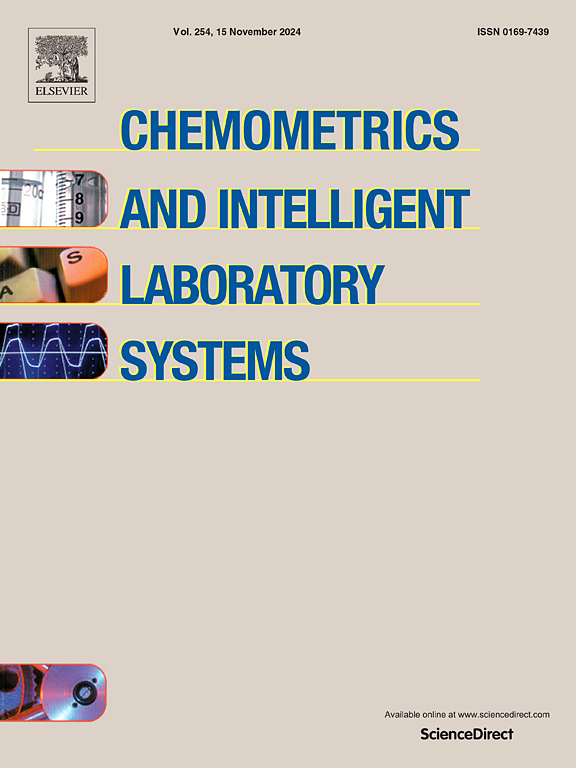基于近红外实验室光谱的土壤质地分类精度评估
IF 3.8
2区 化学
Q2 AUTOMATION & CONTROL SYSTEMS
Chemometrics and Intelligent Laboratory Systems
Pub Date : 2025-05-03
DOI:10.1016/j.chemolab.2025.105419
引用次数: 0
摘要
土壤质地是控制土壤各种物理、化学和生物性质的重要土壤参数。可见近红外(VNIR)光谱学以其简单、无损、无危害、快速等优点而备受关注。由于它的普及,许多研究采用这种技术,而不坚持对预测分数的统一约束。本研究旨在通过实验室近红外光谱评估USDA纹理三角土壤纹理分类的准确性。本研究评估了五种不同的方法:i) 4种方法(A1-A4)定义为回归辅助分类技术,基于偏最小二乘回归(PLSR)方法预测定量分数,然后基于USDA纹理三角形进行纹理分类;ii) 1种方法(A5)定义为直接分类方法,基于偏最小二乘判别分析(PLS-DA)分类器直接利用光谱对土壤纹理进行分类。每种回归辅助分类方法在预测分数和确保预测分数的统一约束方面都有所不同。在方法A1中,对每个样品的PLSR预测的粘土、粉砂和砂组分进行归一化,以确保求和统一。在方法A2中,粉土含量作为每个样品的PLSR预测的粘土和砂含量的残余物,确保了统一性。在方法A3中,使用PLSR的多输出变体同时预测粘土、粉砂和砂组分。方法A4对对数比变换(LRT)分数采用PLSR,实现了同时预测,并固有地保证了求和统一。LRT方法A4利用土壤纹理的相对分量信息,而不是绝对分量信息。对于基于回归的分数预测,方法(A1-A4)取得了类似的效果,粘土的平均决定系数(R2)为0.88-0.90 (RMSE: 4.2 - 4.4%),砂的平均决定系数(R2)为0.82-0.84 (RMSE: 6.1 - 6.5%),但淤泥的平均决定系数(R2 = 0.29-0.38)较低(RMSE: 3.8 - 4.1%)。方法A2将淤泥推断为残余,得出的淤泥预测结果较差。尽管存在这些数量上的差异,USDA纹理三角形的分类精度仍然很高,A1-A4的总体精度为71 - 71.8%,平均精度为62.4 - 65.3%,Cohen's Kappa为0.61-0.62,而A5的总体精度仅为56.4%,Cohen's Kappa为0.42。在回归辅助方法中,方法A4采用粘土、粉土和砂土的对数比变换,同时加强了成分约束,并且在需要较少模型的情况下达到了最佳分类效果(OA = 71.4%, AA = 65.3%, K = 0.62)。研究结果表明:1)4种回归辅助分类方法在土壤质地分类方面具有可比性和准确性,2)直接分类方法的表现一般,3)回归辅助分类方法的表现优于直接分类方法,4)在任何一种方法中,错误分类通常是在邻近的纹理类别中。本研究通过评价土壤质地的性能和适宜性,有助于建立准确有效的土壤质地分类方法。其中,涉及PLSR和对数比转换的A4方法显示出前景,值得在更广泛的数据集和机载或星载平台的潜在应用上进行进一步评估。本文章由计算机程序翻译,如有差异,请以英文原文为准。
Assessing soil texture classification accuracy based on VNIR lab spectroscopy
Soil texture is an important soil parameter controlling various physical, chemical and biological soil properties. Visible Near-Infrared (VNIR) spectroscopy has garnered attention due to its simplicity, non-destructive nature, absence of hazards and rapidity. Due to its popularity, numerous studies employ this technique without adhering to the unity constraint on predicted fractions. This study aims to assess the accuracy of soil texture classification in the USDA textural triangle through laboratory VNIR spectra. Five different approaches were evaluated in this study: i) four approaches (A1-A4), defined as regression-assisted classification techniques, were based on the Partial Least Squares Regression (PLSR) method to predict quantitative fractions followed by a texture classification based on the USDA texture triangle and ii) one approach (A5), defined as a direct classification method, was based on the Partial Least Squares Discriminant Analysis (PLS-DA) classifier to classify soil texture using spectra directly. Each regression-assisted classification approach varies in predicting fractions and ensuring the unity constraint on the predicted fractions. In approach A1, the clay, silt and sand fractions predicted by PLSR for each sample were normalized to ensure sum-to-unity. In approach A2, the silt content was derived as residual from the clay and sand contents predicted by PLSR for each sample, ensuring unity. In Approach A3, the clay, silt and sand fractions were simultaneously predicted using a multi-output variant of PLSR. Approach A4 employed PLSR on log-ratio transformed (LRT) fractions, enabling simultaneous prediction and inherently ensuring sum-to-unity. Approach A4 via LRT utilizes information about the relative fractions of soil texture instead of the absolute fractions. For the regression-based fraction predictions, approaches (A1-A4) achieved similar performances, with mean coefficients of determination (R2) of 0.88–0.90 for clay (RMSE: 4.2–4.4 %), 0.82–0.84 for sand (RMSE: 6.1–6.5 %), but lower (R2 = 0.29–0.38) for silt (RMSE: 3.8–4.1 %). Approach A2, which infers silt as a residual, yielded poorer silt predictions. Despite these quantitative differences, the resulting classification accuracies in the USDA texture triangle were high with overall accuracy of 71–71.8 %, average accuracy of 62.4–65.3 % and Cohen's Kappa of 0.61–0.62 for A1-A4 while A5, attained only 56.4 % overall accuracy and Cohen's Kappa of 0.42. Among the regression-assisted methods, Approach A4 using log-ratio transformations of clay, silt, and sand simultaneously enforced compositional constraints and matched the best classification performances (OA = 71.4 %, AA = 65.3 %, K = 0.62) while requiring fewer models. This work highlighted that i) the four regression-assisted classification approaches provided comparable and correct performances of soil texture classification, ii) the direct classification approach provided modest performance, iii) regression-assisted classification approaches outperformed the direct classification approach, and iv) in any of the approaches, the misclassifications were typically into the neighbouring textural classes. This study aided in the creation of accurate and effective approaches for classifying soil texture by evaluating their performance and suitability. Among these, Approach A4, involving PLSR with log-ratio transformation, displays promise and warrants further evaluation on broader datasets and potential application on airborne or spaceborne platforms.
求助全文
通过发布文献求助,成功后即可免费获取论文全文。
去求助
来源期刊
CiteScore
7.50
自引率
7.70%
发文量
169
审稿时长
3.4 months
期刊介绍:
Chemometrics and Intelligent Laboratory Systems publishes original research papers, short communications, reviews, tutorials and Original Software Publications reporting on development of novel statistical, mathematical, or computer techniques in Chemistry and related disciplines.
Chemometrics is the chemical discipline that uses mathematical and statistical methods to design or select optimal procedures and experiments, and to provide maximum chemical information by analysing chemical data.
The journal deals with the following topics:
1) Development of new statistical, mathematical and chemometrical methods for Chemistry and related fields (Environmental Chemistry, Biochemistry, Toxicology, System Biology, -Omics, etc.)
2) Novel applications of chemometrics to all branches of Chemistry and related fields (typical domains of interest are: process data analysis, experimental design, data mining, signal processing, supervised modelling, decision making, robust statistics, mixture analysis, multivariate calibration etc.) Routine applications of established chemometrical techniques will not be considered.
3) Development of new software that provides novel tools or truly advances the use of chemometrical methods.
4) Well characterized data sets to test performance for the new methods and software.
The journal complies with International Committee of Medical Journal Editors'' Uniform requirements for manuscripts.

 求助内容:
求助内容: 应助结果提醒方式:
应助结果提醒方式:


